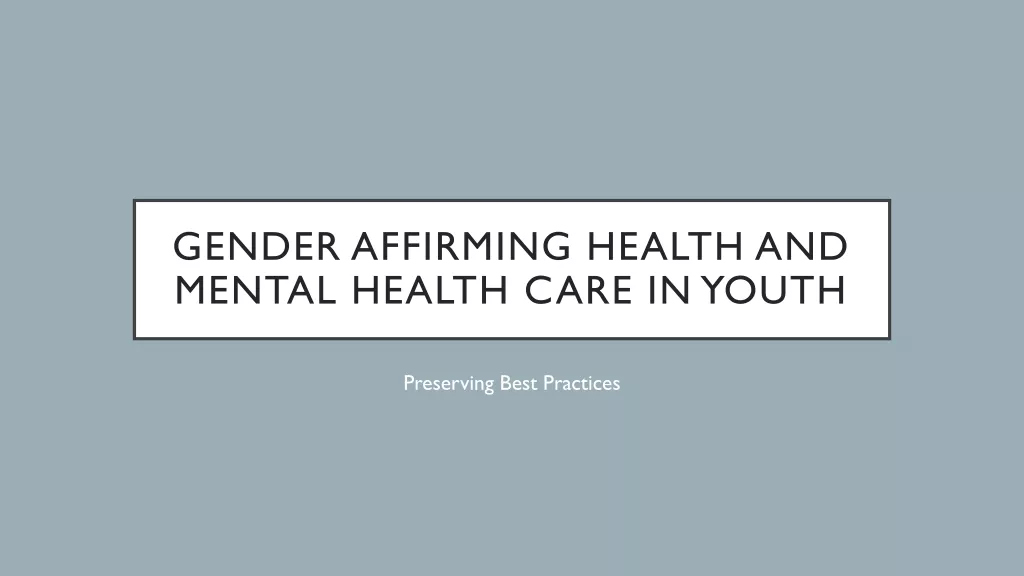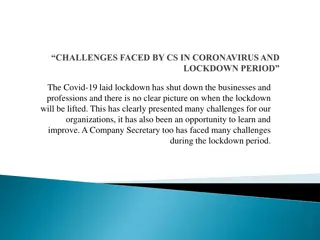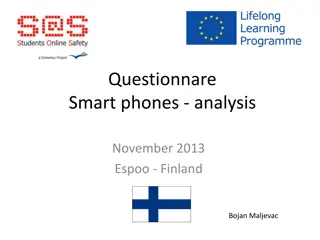Study on Smartphone Addiction Across Age and Gender During Italian COVID-19 Lockdown
This pilot study aims to investigate smartphone dependence levels during the Italian lockdown for COVID-19. Nomophobia, the fear of being without a mobile phone, is explored, highlighting its impact on individuals' behaviors and emotions. The study reveals how smartphones served as crucial tools for communication and coping during the pandemic, leading to increased reliance and potential negative repercussions. The research sheds light on the evolving relationships between individuals and their smartphones in challenging times.
Download Presentation

Please find below an Image/Link to download the presentation.
The content on the website is provided AS IS for your information and personal use only. It may not be sold, licensed, or shared on other websites without obtaining consent from the author.If you encounter any issues during the download, it is possible that the publisher has removed the file from their server.
You are allowed to download the files provided on this website for personal or commercial use, subject to the condition that they are used lawfully. All files are the property of their respective owners.
The content on the website is provided AS IS for your information and personal use only. It may not be sold, licensed, or shared on other websites without obtaining consent from the author.
E N D
Presentation Transcript
Smartphone Addiction through age and gender during Italian lockdown for COVID-19 PASQUALE CAPONNETTO LUCIO INGUSCIO SARA VALERI MARILENA MAGLIA RICCARDO POLOSA CARLO LAI GIULIANA MAZZONI
Background The dependencies related to the Internet, technologies and smartphones are define as Dependencies 2.0
A pilot study The aim of the work is to document the level of smartphone dependence that people manifested during Italian lockdown for Covid-19
Introduction Technologies are useful resources in pandemic time because they allow people to communicate with others Our analysis aimed to document the frequency of smartphone use in the Italian context using the NoMobilePhobia-Questionnaire
Introduction Nomophobia (no-mobile-phobia or Disconnection Syndrome) is the fear of not being able to consult your mobile phone or not being connected or traceable. This fear consequently evokes reactions of anxiety with specific physiological related (breathlessness, sweating, tremor, heart acceleration, sweating) Johnson et al, 2014
Introduction In a study (Yildirim, Correia 2015) some key dimensions of nomophobia were related to the fear of being without smartphones: Be disconnected Not being able to communicate with others Lack of access to information Give up comfort
Introduction People with nomophobia search the smartphone constantly, check it every time that they can do it (in the bathroom, during the shower, etc.) and they have feelings of helplessness when are separated from it. We know that the mobile phone is an integral part of our life that is useful to communicate, to socialize but also to organize our lives (calendar, alarn, clock, mobile banck etc.)
Introduction During lockdown for Covid-19 people made excessive use of the mobile phone as it proved to be a tool capable of replacing, at least in part, perceived shortcomings, especially at the relational level. Therefore, in emergency circumstances, being unable to access smartphone functions may have generated feelings of irritability and anxiety resulting in attitudes of dependence on such devices
Introduction Research on this phenomenon is still limited but those available to date reveal that nomophobia is quite widespread in the population. A study conducted in India found that about 22% of participants had significant levels of nomophobia and more than half of the respondents, about 60%, had moderate symptoms (Farooqui, Pore, Gothankar, 2018)
Introduction Nomophobia is therefore a growing problem in addition to other behavioural addictions related to the use of technologies. This problem will grow exponentially and to affect especially the new generations. The National Institute on Drug Abuse for Teens suggests that smartphone absence anxiety may be more common among teens and young people (NIDA for teens) because they are digital natives and the smartphone is often an integral part of their lives
Introduction In order to diagnose the presence or not of pathology, a test has been developed (the only one currently validated in Italy) which is able to discriminate people potentially at risk from those at low risk The Nomophobia Questionnaire (NMP-Q) is a questionnaire containing twenty items. For each of them, the subject can express his consent on a likert scale ranging from 1 (totally disagree) to 7 (completely agree). The sum of the scores reveals the presence or not of nomophobia (Yoldrim-Correia, 2015)
Introduction We have conducted a study aimed at administering NMP-Q to the Italian population during the lockdown for Covid-19 The aim of our research was to identify those who were potentially at risk or who had increased smartphone use during the social isolation until they experienced feelings of extreme discomfort without connection
Methods The research was based on the administration to Italian people of the NoMobilePhobia-Questionnaire (NMP-Q) The study was approved by the IERB of the Department of Education Sciences University of Catania. The study was conducted in agreement with the ethical norms set by the Italian National Psychological Association
Structure of NMP-Q The NMP-Q is based on four dimensions related to the dysfunctional use of the smartphone: Not being able to communicate; 1. Lose connection; 2. Not being able to access the 3. information; Give up comfort 4. Yildirim & Correia, 2015
Scoring Scores of 20 or less indicate the absence of nomophobia; Scores between 21 and 59 indicate a light form of nomophobia, not dysfunctional for the individual; Scores between 60 and 99 contain moderate levels of nomophobia; Scores between 100 and 140 are associated with severe rates of nomophobia, capable of inducing as mentioned serious states of separation anxiety
Scoring The final score, given by the sum of the individual values provided in each of the statements, is a Dependent Variable contained in our Dataset and named Score . Each person who participated in the study is identified with a unique code that combines that variable with information such as Age and Gender. In addition, based on age the subject was assigned to one of these groups: Group 1 (ages in years 15-24) Group 2 (ages in years 25-34) Group 3 (ages in years 35-44) Group 4 (ages in years 45-54) Group 5 (age in years 55-67)
Statistical analysis Independent Variables are: - the "Sex factor in two levels (1st - Male and - the "Age Group" factor in 5 levels (1st Group A; 2nd Group B; 3rd Group C; 4th Group D) 2nd Female) Dependent Variables are equivalent to the "Score"
Results The Dependent Variable taken into account, "Score" allowed us to detect a significant interaction between the "Sex" factor and the "Age Group" factor; For the youngest subjects (from group 1 to group 3), the women group has the highest score on the questionnaire; For older age groups (group 4 to group 5), male subjects report higher scores for the Score variable
Results As age increases in subjects, the score they get by compiling the NoMobilePhobia-Questionnaire increases, we did not detect significant major effects due to the gender or age of the subjects
Results Female subjects report significantly higher than the male gender (Ss of age group 1,2,3). Male subjects report significantly higher scores than female subjects (Ss of age group 4, 5)
Results The main effects of the "Sex" factor [F(1,1256)= "Age_class" [F(4,1253)=1.82 and p=0.12] are not significant; the interaction 3.179 and p=0.75] and between the Sex-Age_class factors is significant with F(4,1253) =7.06 and p<.001 and an observed power close to 1 (0.99)
Results The correlation between the Variable "Score" and the measure of the "Age" was found to be significant (negative) linear relationship (r of Pearson =-.093 and p<.001) considering the whole sample If we compare the male group with that of the Females, the correlation is significant in negative linear relationship for the Females (r of Pearson =.159 and .001 in two queues) and is not significant for the Male group (r of Pearson =.026 and p .368). So we can say that for the group of females as they get older, the score reported in the test decreases significantly























